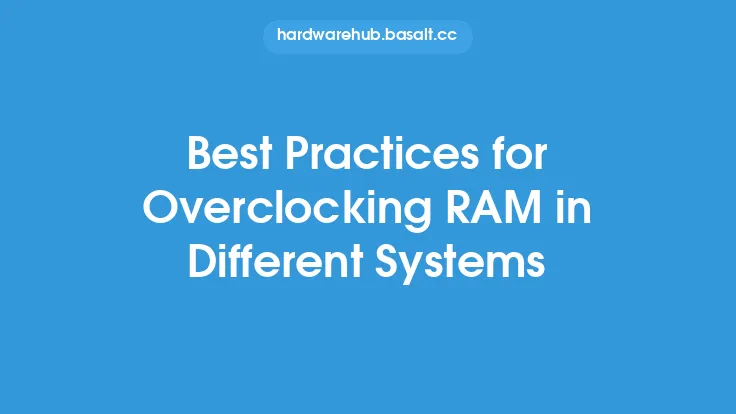When it comes to installing RAM, there are several best practices to follow in order to ensure optimal performance. One of the most critical aspects is to handle the RAM modules with care, as they are sensitive to static electricity and can be easily damaged. It's essential to touch a grounded metal object or wear an anti-static wrist strap to discharge any static electricity from your body before handling the RAM modules. This will prevent any damage to the modules and ensure they function properly.
Understanding RAM Types and Compatibility
To ensure optimal performance, it's crucial to understand the different types of RAM and their compatibility with your system. There are several types of RAM, including DDR3, DDR4, and DDR5, each with its own unique characteristics and specifications. DDR3 RAM, for example, has a maximum speed of 1600 MHz, while DDR4 RAM can reach speeds of up to 3200 MHz. DDR5 RAM, on the other hand, offers even faster speeds and higher capacities. When selecting RAM, it's essential to choose modules that are compatible with your system's motherboard and processor. Checking the motherboard manual or manufacturer's website can provide information on the type and speed of RAM supported.
Installing RAM in the Correct Orientation
Another critical aspect of RAM installation is ensuring the modules are installed in the correct orientation. RAM modules have notches on the bottom that correspond to tabs on the RAM slot. Aligning these notches with the tabs is essential to ensure the module is installed correctly. Installing a RAM module in the wrong orientation can prevent it from functioning properly or even damage the module or the motherboard. It's also important to ensure the RAM module is fully seated in the slot, with the notches securely locked into place.
Configuring RAM for Optimal Performance
To achieve optimal performance, it's essential to configure the RAM correctly. This includes installing the RAM modules in the correct slots, as specified in the motherboard manual. Some motherboards have specific slots for certain types of RAM, such as single-channel or dual-channel configurations. Installing RAM modules in the correct slots can help improve performance by allowing the system to take full advantage of the RAM's capabilities. Additionally, configuring the RAM settings in the BIOS can also impact performance. Settings such as the RAM speed, timing, and voltage can be adjusted to optimize performance, but it's essential to be cautious when making these adjustments, as incorrect settings can cause system instability.
Avoiding Overheating and Ensuring Proper Cooling
RAM modules can generate heat during operation, and excessive heat can impact performance and reduce the lifespan of the modules. To avoid overheating, it's essential to ensure proper cooling. This can be achieved by installing a heat sink or fan near the RAM modules or by using a RAM cooler specifically designed for this purpose. Additionally, ensuring good airflow within the system can also help keep the RAM modules cool. It's also important to monitor the system's temperature and adjust the cooling settings as needed to prevent overheating.
Verifying RAM Installation and Troubleshooting
After installing the RAM, it's essential to verify that it's recognized by the system and functioning properly. This can be done by checking the system's specifications or using software tools to detect the RAM. If the RAM is not recognized or is not functioning properly, troubleshooting may be necessary. Common issues include incorrect installation, incompatible RAM, or conflicts with other system components. Checking the motherboard manual or manufacturer's website can provide troubleshooting guides and tips to resolve these issues.
Upgrading and Expanding RAM
As systems evolve and require more memory, upgrading or expanding the RAM may be necessary. When upgrading or expanding RAM, it's essential to follow the same best practices as when installing new RAM. This includes handling the RAM modules with care, installing them in the correct orientation, and configuring them for optimal performance. Additionally, it's essential to ensure the new RAM is compatible with the existing RAM and the system's motherboard and processor. Mixing different types or speeds of RAM can impact performance, so it's essential to choose compatible modules.
Conclusion and Future-Proofing
In conclusion, installing RAM requires careful attention to detail and adherence to best practices to ensure optimal performance. By understanding the different types of RAM and their compatibility, installing RAM in the correct orientation, configuring RAM for optimal performance, avoiding overheating, and verifying RAM installation, users can ensure their system is running at its best. As technology continues to evolve, future-proofing the system by choosing compatible and upgradable RAM can help extend the system's lifespan and ensure it remains capable of handling demanding applications and tasks. By following these best practices and staying informed about the latest developments in RAM technology, users can ensure their system is always running at its best.





